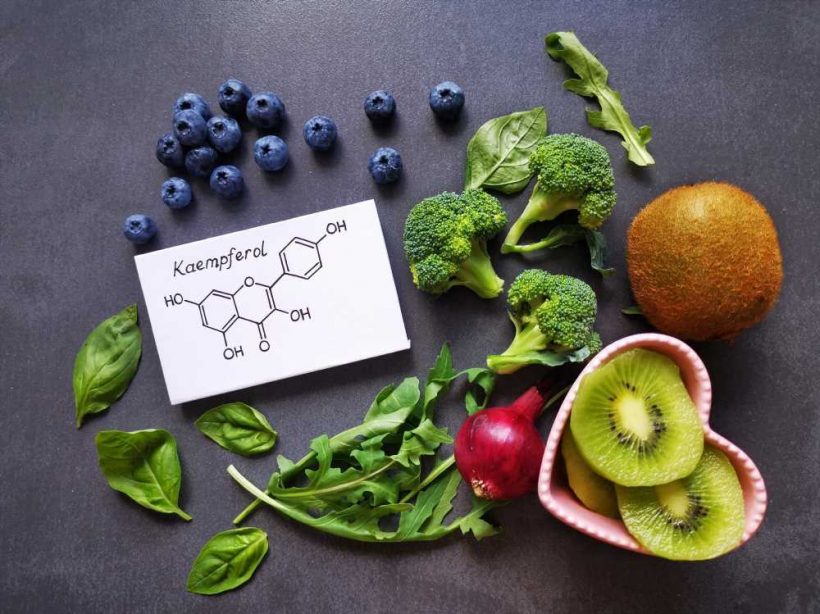In a recent study published in the Biomedicine & Pharmacotherapy journal, researchers explored the anti-allergic and anti-inflammatory properties of flavonoids.
Chronic inflammation is crucial to the initiation and progression of chronic disorders such as diabetes, cancer, hypertension, asthma, and allergies. Bioactive flavonoids are plentiful in numerous food groups, including vegetables, nuts, fruits, drinks, and cereals. Recent research on flavonoids has revealed their capacity to regulate or prevent inflammation. Due to their antioxidative, anti-inflammatory, and immune-modulatory capabilities, flavonoids are an indispensable ingredient in pharmaceutical, nutraceutical, and medical applications. However, extensive research is required to understand the anti-inflammatory mechanism of these compounds.
 Anti-inflammatory and anti-allergic potential of dietary flavonoids: A review. Image Credit: Danijela Maksimovic / Shutterstock
Anti-inflammatory and anti-allergic potential of dietary flavonoids: A review. Image Credit: Danijela Maksimovic / Shutterstock
Flavonoids as effective anti-inflammatory agents
Flavonoids function as anti-inflammatory agents by blocking the transcription factors as well as regulatory enzymes responsible for inflammation and its propagation, among other mechanisms. Various kinases, including C-protein kinase, phosphoinositol kinase, tyrosine kinase, cyclin-dependent kinase-4, or phosphatidylinositol kinase, are involved in signal transduction via lipid or protein phosphorylation and play an essential role in cell activation during inflammation. Flavonoids may potentially affect protein kinases by suppressing the nuclear factor kappa-B (Nf-κB). Several studies have demonstrated that flavonoids can modulate IkB and Nf-κB, which directly correlate with cell activation. In addition, they regulate transcription factors like signal transducer and activator of transcription (STAT)-6 and GATA-3 of CD4+T helper 2 (Th2) cytokines.
Flavonoids as an anti-allergic agent
Approximately four different types of allergic immunological responses develop following allergen or medication exposure. Type 1, which is Th-cell-mediated, is the focus of the investigation. It consists of two phases, namely the inductive phase involving the formation of immunoglobulin (Ig)-E against allergen in the presence of Th2 predominance. The second phase is the triggering phase involving the robust secretion of chemical mediators from immune cells, including the mast cells, which then re-interact with the allergen. The flavonoid's interference with Th-cell activation appears to be the primary mechanism for suppressing allergic reactions. By taking this approach, flavonoids can play a pathological role in treating allergy-related conditions.
in vitro and in vivo studies of flavonoids
Luteolin, myricetin, kaempferol, and quercetin were found to be beneficial against allergy-specific cytokines in in vitro and in vivo experiments. All have been reported to inhibit the generation of interleukin (IL)-4 and IL-13 from mast cells and basophils.
Quercetin
Quercetin is a potential component due to its antioxidant action in radical scavenging and anti-allergic characteristics manifested via immunological activation. It also functions as an antihistamine and anti-inflammatory agent by decreasing the production of histamine from both basophils and mast cells, respectively, and by preventing the secretion of pro-inflammatory cytokines. In vitro and in vivo studies exhibited quercetin's anti-allergic and anti-inflammatory properties. Both galangin and quercetin alleviated atopic dermatitis in macrophages activated with lipopolysaccharide (LPS) by targeting the NF-κB, extracellular signal-regulated kinases (ERKs)-1/2, and c-Jun N-terminal kinase (JNK) pathways. In addition, galangin and quercetin alone or together reduce serum IgE and ameliorate skin lesions in a balb-c mouse model of atopic dermatitis (AD).
Kaemferol
Kaemferol is a plant-based flavonol with anti-allergic, anti-inflammatory, and antioxidant activities demonstrated in animal and human studies. By interfering with NF-κB signaling, it significantly controls allergic airway inflammation among mice. Kaempferol decreased the CD69 expression and the generation of allergen-inducing inflammatory cytokines, such as IL-12. In addition, pulldown experiments demonstrated that kaempferol reduces the activity of multidrug resistance-associated protein 1 (MRP-1) by directly binding to it. Kaempferol inhibited the TAK1-IKK-mediated NF-κB pathway as well as JNK phosphorylation in activated T-cells. Similar to in vitro research, kaempferol improved the appearance of atopic dermatitis among mice.
Myricetin
Myricetin possesses antioxidant, anti-inflammatory, and anti-allergic characteristics. Toluene 2,4-diisocyanate–induced (TDI) allergic mice exhibited decreased sneezing, erythema, rhinorrhea, and edema following oral treatment of Sonneratia caseolaris crude extract. It has also been found that polyphenolic chemicals, in particular vanillic acid, myricetin, and ellagic, reduced allergic symptoms by directly binding to histamine receptors and suppressing the production of Th-cell cytokines that are involved in the allergic illness.
Luteolin
The anti-allergic activity of luteolin was investigated in Balb-c mice with asthma caused by ova-albumin. In a mouse model, Luteolin-treated animals exhibited reduced allergy symptoms, including decreased infiltration of inflammatory cells as well as Th2-mediated inflammatory cytokines. Rats with allergic rhinitis were studied to determine how luteolin helps alleviate allergic inflammation and Th1/Th2 balance by regulating the toll-like receptor 4 (TLR4)/NF-κB pathway. In ova-albumin-induced allergic mice, the Artemisia argyi component luteolin significantly decreased airway hypersensitivity, inflammatory cell count, Th2, and IgE cytokines.
Overall, the study findings showed that flavonoids possess anti-inflammatory, antioxidant, and anti-allergic characteristics. Recent studies of four key anti-inflammatory and anti-allergic flavonoids have confirmed their beneficial effects on allergic diseases by balancing Th1/ Th2 cells and impairing the stimulation of basophils and mast cells.
- Allah Rakha, Nehal Umar, Roshina Rabail, Masood Sadiq Butt, Marek Kieliszek, Abdo Hassoun, Rana Muhammad Aadil, Anti-inflammatory and anti-allergic potential of dietary flavonoids: A review, Biomedicine & Pharmacotherapy, Volume 156, 2022, 113945, ISSN 0753-3322, DOI: https://doi.org/10.1016/j.biopha.2022.113945, https://www.sciencedirect.com/science/article/pii/S0753332222013348
Posted in: Medical Research News | Medical Condition News | Women's Health News
Tags: Airway Inflammation, Albumin, Allergen, Allergic Rhinitis, Allergy, Antihistamine, Anti-Inflammatory, Antioxidant, Asthma, Atopic Dermatitis, Biomedicine, Cancer, CD4, Cell, Chemicals, Chronic, Cyclin-dependent Kinase, Cytokines, Dermatitis, Diabetes, Edema, Erythema, Flavonoid, Food, Histamine, Hypersensitivity, Immunoglobulin, in vitro, in vivo, Inflammation, Interleukin, Kinase, Mouse Model, Nutraceutical, Phosphorylation, Propagation, Protein, Quercetin, Receptor, Research, Rhinitis, Rhinorrhea, Skin, Sneezing, Transcription, Transcription Factors, Tyrosine, Vegetables

Written by
Bhavana Kunkalikar
Bhavana Kunkalikar is a medical writer based in Goa, India. Her academic background is in Pharmaceutical sciences and she holds a Bachelor's degree in Pharmacy. Her educational background allowed her to foster an interest in anatomical and physiological sciences. Her college project work based on ‘The manifestations and causes of sickle cell anemia’ formed the stepping stone to a life-long fascination with human pathophysiology.
Source: Read Full Article






